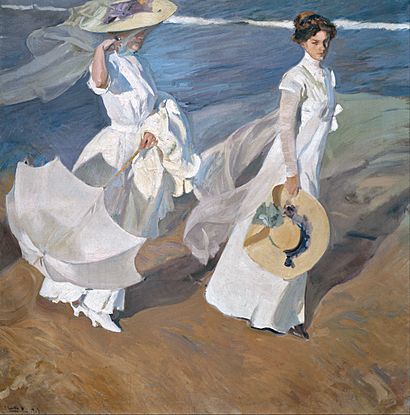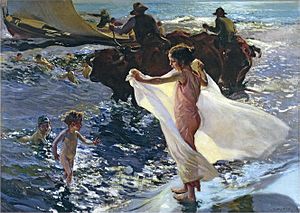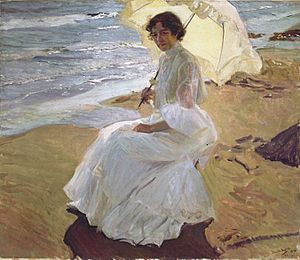Walk on the Beach facts for kids
Quick facts for kids Walk on the Beach |
|
|---|---|
| Spanish: Paseo a la orilla del mar / Paseo a orillas del mar | |
 |
|
| Artist | Joaquín Sorolla |
| Year | 1909 |
| Medium | oil on canvas |
| Dimensions | 205 cm × 200 cm (81 in × 79 in) |
| Location | Sorolla Museum, Madrid |
Walk on the Beach (also known as Paseo a la orilla del mar or Paseo a orillas del mar in Spanish) is a famous oil painting from 1909. It was created by the Spanish artist Joaquín Sorolla.
Contents
About the Painting
This large painting is about 205 centimeters tall and 200 centimeters wide. It shows Sorolla's wife, Clotilde, and their oldest daughter, María, enjoying a walk on the beach in Valencia, Spain. You can find this beautiful artwork at the Sorolla Museum in Madrid.
Sorolla's Big Year: 1909
The year 1909 was a huge success for Joaquín Sorolla. He was already well-known in Spain, France, and Germany. But 1909 was a high point in his art career.
Sorolla's Trip to America
At the start of 1909, Sorolla traveled to New York City with his wife and two older children, María and Joaquín. He was invited by an American art collector named Archer M. Huntington. Huntington had just opened the Hispanic Society of America. Sorolla was asked to show his paintings there. This was Sorolla's first trip across the Atlantic Ocean.
His art show opened on February 4, 1909. At first, only a few people came. But soon, very positive reviews appeared in newspapers. More and more visitors came to see his work. By the time the exhibition closed on March 8, 169,000 people had seen Sorolla's paintings!
Because of this amazing success, a slightly different collection of his art was also shown in Buffalo and Boston. While in the United States, Sorolla received 20 requests to paint portraits. One of these was for the newly elected US President, William Howard Taft. Sorolla even visited him at the White House in Washington, D.C.
When Sorolla left the United States in May 1909, he had sold 195 paintings. Two of his works were bought by the Metropolitan Museum of Art. He earned a huge amount of money: 181,760 US dollars!
A Productive Summer in Valencia
After his successful trip to America, Sorolla returned to Europe. He first stopped in Paris. There, he showed his 1903 painting Evening Sun at an art exhibition. This painting showed fishermen from Valencia.
He then traveled through Madrid to Valencia, where he met his daughter Elena and the rest of his family. He visited a local art show called Exposicion Regional and won an award.
Feeling inspired by his success in America and the good reviews, he had a very busy summer. He planned to go back to the United States for another exhibition in 1911 and needed new paintings. He stayed in Valencia until the end of September. During these summer months, he created "some of his best and most spectacular beach scenes," as noted by his granddaughter and biographer, Blanca Pons-Sorolla. The beach paintings he made that summer, including Walk on the Beach, are considered a highlight of his career.
Sorolla's Beach Paintings
Joaquín Sorolla was born in Valencia, a city by the sea. So, he knew a lot about life near the ocean from a young age.
Early Sea-Themed Works
In his early paintings, he created traditional port scenes. For example, Marina, Barcos en el Puerto was his first painting shown at an art exhibition in Madrid in 1881. In the 1890s, he often painted fishermen from Valencia. In some very large paintings, he showed fishermen bringing their catch to shore. He also painted boat builders or women selling fish. These paintings showed working people by the sea, not just people enjoying leisure time.
These works received great reviews and won awards. They also brought him international fame. The French government bought his painting The Return from Fishing from 1895. The Berlin National Gallery bought Valencian Fishermen from 1895.
Children and Leisure at the Beach
Around 1900, Sorolla started painting children bathing. In his 1904 painting The Hour of the Bath, he combined fishing and bathing children. It shows children swimming near a fishing boat and an ox in the water. In the front, a child comes out of the sea, and a young woman waits with a white cloth to dry the child. This painting already hints at themes in Walk on the Beach. For example, the white cloth moving in the wind is important. The area between the water and the beach is soft, and the whole picture is filled with the light of early evening.
That same summer, Sorolla painted his wife, Clotilde, in Valencia. In Clotilde on the Beach, his wife sits on a stool near the sea in a white dress. Here, just like in Walk on the Beach, a parasol is an important item. The open parasol casts shadows on her face. In Walk on the Beach, her face is hidden by a veil. In Clotilde on the Beach, the painter stood a little higher, so you can't see the horizon line. Instead of the beach in the foreground, the painting goes straight into the sea waves, with no sky visible.
In 1906, Sorolla and his family visited Biarritz in France. In the group portrait Walk by the Lighthouse, several women walk along cliffs above the beach. The painter shows the beach and underwater rock formations in the background. The women are arranged loosely side by side. Again, white clothing is common, but a young girl in the middle stands out in a bright red jacket. Large hats and parasols are also important items in this painting.
In 1909, he returned to the beach in Valencia. He again painted people by the sea. In the portrait Elena on the Beach, Sorolla painted his youngest daughter in a white dress with the beach behind her. This portrait, made around the same time as Walk on the Beach, shows the meeting of land and sea, the waves, a dress moving in the wind, a hat, and the bright light of a summer day in the Mediterranean.
Where the Painting Is Now
The painting stayed with the artist until he passed away. In his will, he left the painting to his son, Joaquín Sorolla García. His son was the first director of the museum in his parents' old home, which became the Sorolla Museum.
In 1931, Sorolla's wife, Clotilde, gave their house and all its contents to the Spanish government. This was done to help create a Joaquín Sorolla museum. Following his mother's generous example, Joaquín Sorolla García also left Walk on the Beach and other works by his father to the Spanish government after he died in 1948. Since then, the painting has been part of the collection at the Sorolla Museum in Madrid.
See also
 In Spanish: Paseo a orillas del mar para niños
In Spanish: Paseo a orillas del mar para niños






